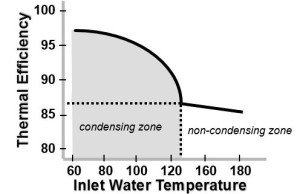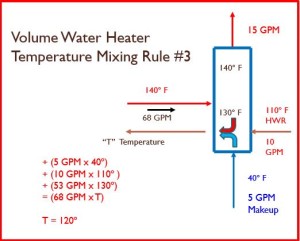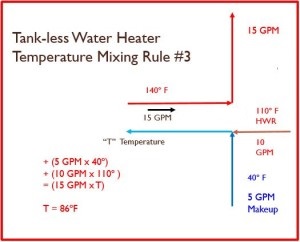There are two parts to the real story behind tankless water heaters and volume water heaters: energy and cost of ownership. This week, we look at the energy usage of these two technologies.
Radiant Losses through the Tank
Let’s start with what is normally thought of as the 2000-lb gorilla. Most people think that the BTUH loss from the tank, with its volume of water at 140°F, is a real waste of energy. As a company that sells and assists in design of volume water heaters and tankless water heaters, heat loss of the tank is one of the lesser issues when it comes to energy.
Let’s look at an example. Assume we have a system with a requirement for an 850,000 BTUH water heater with a 500 gallon, 36” diameter by 84” high tank. Let’s also assume the tank is storing 140°F water. Due to stratification in the tank, the bottom 1/3 of the tank is allowed to cool to 130°F. Many tanks allow cooler temperatures to avoid cycling too often, but let’s assume these numbers.
The ASHRAE Standard 90.1 for energy-saving design has helped with the heat loss. In commercial applications, these tanks normally have R-12.5 insulation or better. Let’s look at a formula, because we engineers like them. Given a temperature difference of 140°F in the tank minus 70°F in the space, we have a ΔT of 70°F. The area of the tank surface is about 70 square feet (I’ll let you do the math). The heat loss is:
BTUH = (1 X 70 X 65)/12.5, or about 364 BTUH
In our example, the loss through the tank is not significant.
Water Heater Efficiency
The condensing-style water heater efficiency is affected by the water temperature entering the heater. ASHRAE HVAC Systems and Equipment chapter 32 shows a chart of efficiency vs. return water temperature. Basically, the colder the entering water, the higher the efficiency.
When cold water enters a volume storage tank and heater, the cold water mixes with the hot tank water and the recirculated water return flow. The water is pumped from the tank to the heater at a large flow rate. This mixed water temperature is what enters the heater. Here is a slide from our basic domestic water hot water heater class.
We use the same “law of the tees” that we use in primary secondary piping systems, since the tank is that low pressure drop common pipe. As the fixture use increases, the return water temperature from the tank to the heater decreases. Since we are only at full flow rate demand for a small fraction of the time, we are always getting mixed return temperatures.
If we don’t have the tank, the mixing is reduced.
Tankless Water Heaters Are More Efficient.
The net result is that tankless water heaters are anywhere from 5% to 8% more efficient due to the reduced inlet water temperature.
Next week we’ll look at cycling costs in the Monday Morning Minute post.




